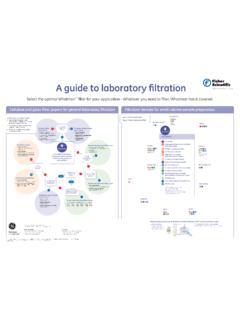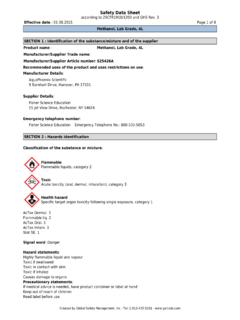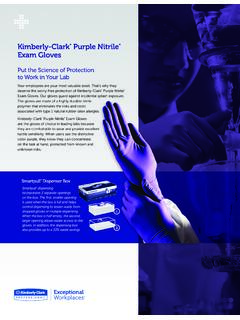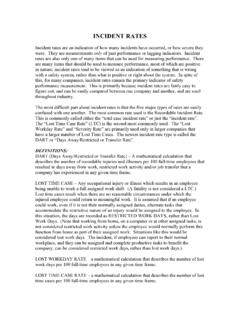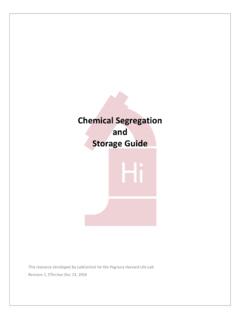Transcription of 5210 BIOCHEMICAL OXYGEN DEMAND (BOD)* 5210 A ... - …
1 5210 biochemical oxygen demand (BOD)*5210 A. DiscussionThe BIOCHEMICAL OXYGEN DEMAND (BOD) determination is anempirical test in which standardized laboratory procedures areused to determine the relative OXYGEN requirements of wastewa-ters, effluents, and polluted waters. The test has its widest ap-plication in measuring waste loadings to treatment plants and inevaluating the BOD-removal efficiency of such treatment sys-tems. The test measures the molecular OXYGEN utilized during aspecified incubation period for the BIOCHEMICAL degradation oforganic material (carbonaceous DEMAND ) and the OXYGEN used tooxidize inorganic material such as sulfides and ferrous iron.
2 Italso may measure the amount of OXYGEN used to oxidize reducedforms of nitrogen (nitrogenous DEMAND ) unless their oxidation isprevented by an inhibitor. The seeding and dilution proceduresprovide an estimate of the BOD at pH to of OXYGEN consumed in a 5-d test period (5-dBOD or BOD5, 5210B), OXYGEN consumed after 60 to 90 d ofincubation (ultimate BOD or UBOD, 5210C), and continuousoxygen uptake (respirometric method, 5210D) are describedhere. Many other variations of OXYGEN DEMAND measurementsexist, including using shorter and longer incubation periods andtests to determine rates of OXYGEN uptake.
3 Alternative seeding,dilution, and incubation conditions can be chosen to mimicreceiving-water conditions, thereby providing an estimate of theenvironmental effects of wastewaters and UBOD measures the OXYGEN required for the total degra-dation of organic material (ultimate carbonaceous DEMAND )and/or the OXYGEN to oxidize reduced nitrogen compounds (ul-timate nitrogenous DEMAND ). UBOD values and appropriate ki-netic descriptions are needed in water quality modeling studiessuch as UBOD:BOD5ratios for relating stream assimilativecapacity to regulatory requirements; definition of river, estuary,or lake deoxygenation kinetics.
4 And instream ultimate carbona-ceous BOD (UCBOD) values for model Versus Nitrogenous BODA number of factors, for example, soluble versus particulateorganics, settleable andfloatable solids, oxidation of reducediron and sulfur compounds, or lack of mixing may affect theaccuracy and precision of BOD measurements. Presently, thereis no way to include adjustments or corrections to account for theeffect of these of reduced forms of nitrogen, such as ammonia andorganic nitrogen, can be mediated by microorganisms and exertnitrogenous DEMAND .
5 Nitrogenous DEMAND historically has beenconsidered an interference in the determination of BOD, and theinclusion of ammonia in the dilution water contributes an exter-nal source of nitrogenous DEMAND . The interference from nitrog-enous DEMAND can now be prevented by an inhibitory an inhibiting chemical is not used, the OXYGEN DEMAND mea-sured is the sum of carbonaceous and nitrogenous that include nitrogenous DEMAND generally are notuseful for assessing the OXYGEN DEMAND associated with organicmaterial. Nitrogenous DEMAND can be estimated directly from am-monia nitrogen (Section 4500-NH3); and carbonaceous DEMAND canbe estimated by subtracting the theoretical equivalent of the nitriteand nitrate produced in uninhibited test results.
6 However, thismethod is cumbersome and is subject to considerable error. Chem-ical inhibition of nitrogenous DEMAND provides a more direct andmore reliable measure of carbonaceous extent of oxidation of nitrogenous compounds during the5-d incubation period depends on the concentration and type ofmicroorganisms capable of carrying out this oxidation. Suchorganisms usually are not present in raw or settled primarysewage in sufficient numbers to oxidize sufficient quantities ofreduced nitrogen forms in the 5-d BOD test.
7 Many biologicaltreatment plant effluents contain sufficient numbers of nitrifyingorganisms to cause nitrification in BOD tests. Because oxidationof nitrogenous compounds can occur in such samples, inhibitionof nitrification as directed in ) is recommended forsamples of secondary effluent, for samples seeded with second-ary effluent, and for samples of polluted Reference1. YOUNG, 1973. Chemical methods for nitrification Pollut. Control Fed. 45 B. 5-Day BOD DiscussionThe method consists offilling with diluted and seeded sample,to overflowing, an airtight bottle of specified size and incubatingit at the specified temperature for 5 d.
8 Dissolved OXYGEN ismeasured initially and after incubation, and the BOD is com-puted from the difference between initial andfinal DO. Becausethe initial DO is determined shortly after the dilution is made, all* Approved by Standard Methods Committee, Task Group: James C. Young (chair), George T. Bowman, Sabry , Terry G. Mills, Marlene Patillo, Ray C. organic CONSTITUENTS (5000) OXYGEN uptake occurring after this measurement is included inthe BOD sampling and storage procedures, see Incubation bottles:Use glass bottles having 60 mL orgreater capacity (300-mL bottles having a ground-glass stopperand aflared mouth are preferred).
9 Clean bottles with a detergent,rinse thoroughly, and drain before Air incubator or water bath,thermostatically controlled at20 1 C. Exclude all light to prevent possibility of photosyn-thetic production of reagents in advance but discard if there is any sign ofprecipitation or biological growth in the stock bottles. Commer-cial equivalents of these reagents are acceptable and differentstock concentrations may be used if doses are adjusted propor-tionally. Use reagent grade or better for all chemicals and usedistilled or equivalent water, preferably sterilized, for making Phosphate buffer solution:Dissolve g KH2PO4, gK2 HPO4, 7H2O, and g NH4Cl in about 500mL distilled water and dilute to 1 L.
10 The pH should be further adjustment. Alternatively, dissolve gKH2PO4and g NH4Cl in about 700 mL distilled pH to with 30% NaOH and dilute to 1 Magnesium sulfate solution:Dissolve g MgSO4 7H2 Oin distilled water and dilute to 1 Calcium chloride solution:Dissolve g CaCl2in dis-tilled water and dilute to 1 Ferric chloride solution:Dissolve g FeCl3 6H2 Oindistilled water and dilute to 1 Acid and alkali solutions,1N, for neutralization of caustic oracidic waste ) Acid Slowly and while stirring, add 28 mL conc sulfuricacid to distilled water.




